Interview with Gilles Peress
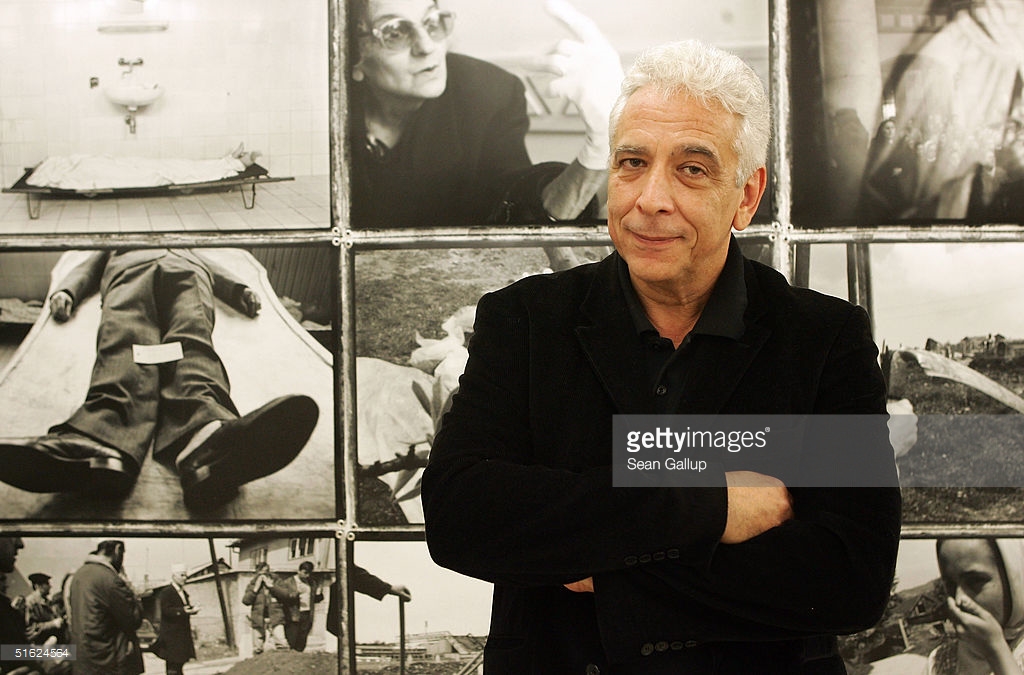
Gilles Peress meets Harry Kreisler of Institute of International Studies, UC Berkeley
Background
Gilles, welcome to Berkeley.
Thank you.
Tell us a little about your background. Where were you educated, and in what subject?
I grew up in France, in Paris, and I studied political science and philosophy. Not photography.
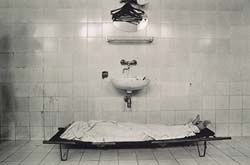 Who were some of the political philosophers that influenced you?
Who were some of the political philosophers that influenced you?
Well, in political science, it was an institute to prepare you for government, so it was prime ministers and people like that. Philosophy was all the postmodern idols and heroes of the day.
Did one in particular most influence you?
They all influenced me incredibly in making me extremely suspicious of language.
Why was that?
I’m like a perfect child of fury. I was force-fed so much of this stuff. At the same time I was dealing with reality. I was extremely involved in the French social reality at the time, and I started to see a huge gap between language and reality.
What is the period that we’re talking about?
The late ’60s.
And is this why, at least in the two books that I mentioned, there is no text, it’s all images?
There is some text but yes, there is an absence of text.
In the Bosnia book there are some letters.
In the previous book I did the text was also minimal. It was telexes from my agency to me and it was more about the business of photography than about what was happening in Iran at the time.
So the move into photography partly reflects the disillusionment and frustrations of the social reality when you were in school?
 Well, it was simply a question of survival: I needed a tool and a vehicle to understand and formalize what was out there in the world, my relationship to reality. If I didn’t have that tool, I most surely would be in some mental asylum somewhere. So it was that I needed something to be able to mediate the relationship to the world, other than language.
Well, it was simply a question of survival: I needed a tool and a vehicle to understand and formalize what was out there in the world, my relationship to reality. If I didn’t have that tool, I most surely would be in some mental asylum somewhere. So it was that I needed something to be able to mediate the relationship to the world, other than language.
What was your first shoot once you were into photography?
At the time I was really involved in social issues. I kept hearing this whole political language of the late ’60s about the working class, the masses, and so on. I kept hearing about those huge victories of the working class, the masses advancing. So the first project I did was actually about a great working-class defeat. It was about a town that had had one of the major strikes of the ’60s and had lost the strike. And it was going back to that town and seeing what happens afterward, after a major defeat.
In the United States a lot of the disillusionment comes from the discontinuity of the words of the politicians and the reality on the ground; but you’re saying that it was disillusionment with the relationship of the words of the left political leaders and the reality?
It’s both, because a lot of language is political language. Even intellectual language is political language. It was the intellectual language, and that was also very much a political language. All the intellectual theories of the late ’60s in France were extremely political. I mean, you couldn’t talk about psychoanalysis without mentioning Marx.
Photography
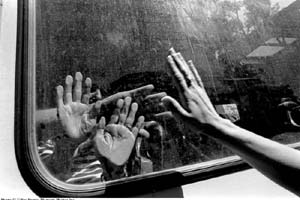 What photographers have influenced you, especially in this early period that we’re talking about?
What photographers have influenced you, especially in this early period that we’re talking about?
None. I mean, at that time in France there were no schools, very few books, there was not a really terrific education. So I started out of my own need and not out of looking at other people’s work. It was not about photography, the primary reason why I did it was not about photography anyway.
So photography was much more than just a job for you. Obviously it became that, but even in the beginning.
I wish it had been a job at the beginning. No, it’s a real tool and vehicle for the relationship to the world. It’s an essential thing, like eating. It’s about surviving, it’s about making sense of what’s out there and what’s in there.
Are you a “photographer” or a “photojournalist”?
I’m really “neither/nor.” Some people ask me if I’m an artist, some ask me if I’m a photojournalist or photographer, or whatever. I always try to escape categories because where those categories are attached, predictable forms, they really have very much to do with market, or where to market the pictures. I’m interested in what’s unpredictable, and I’m interested in what happens in the no-man’s-land between known categories. I’m interested in what happens in a no-man’s-land, say, between “art” and “photojournalism,” or between “photography” and “literature,” or between “photography” and “cinema.” And I’m interested in investigating what’s in that gray area. So it’s very hard to put a category on me that describes what I do. I’m happy with that.
And this no-man’s-land that you’re interested in, is that partly (I’m going to have trouble with words here since you are disillusioned with words) but is this no-man’s-land both a technical no-man’s-land and also substantive — exploring the technical issues in photography, new ways to take pictures, but also exploring the no-man’s-land where all is disorder, where all is anarchy?
Here you’re talking about content; no it’s not technical. I always work very, very hard at making photography extremely transparent. I work upstream of the process to work out all the aspects of the process, from the developers to the printed page. I truly understand all that so it has become transparent and ceases to exist. No, the no-man’s-land has to do with the structure of a language. It has to do with narrative forms. It has to do with figuring out forms to tell stories, to formulate what is reality other than what I’ve seen before. The issue of content is a separate issue, in terms of the kind of subject matter I address myself to.
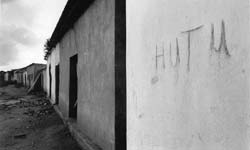 Are you a witness to what you’re seeing as you go to places like Bosnia and Rwanda?
Are you a witness to what you’re seeing as you go to places like Bosnia and Rwanda?
Yes, very much. I see myself as an individual who goes to those places to understand what’s happening, in some way beyond the media. We talked about where I come from, education and so on. My generation was extremely suspicious of the media, and when I started with photography I had no illusions as to where the media, magazines and so on, were in terms of describing reality. So for me to go places like Bosnia or Rwanda, it’s very much as an individual who’s trying to understand for himself what’s really happening, and is trying to take the time and in some way escape the habits and the paths of journalism as it’s normally conceived.
One of the striking things about your images is the extent to which they shake up middle-class complacency and the kind of numbing that comes from the avalanche of essentially commercial images, images that are meant to sell products and so on. Is that a goal?
Do you mean waking up?
Waking up, yes. Pricking the moral conscience of especially the international community and, I think, the individual also.
Philosophical Implications
One of the things that strikes me about your images is how they evoke recollections of the Bible, of images of damnation, the dark images that the Bible contains. Is your background a religious one or is that just what you’re seeing?
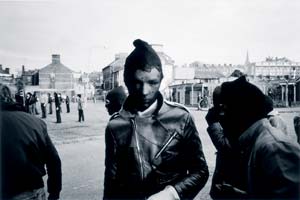 It’s something that happened to me. I was raised out of religion because I come from a mixed family, my father was Jewish and my mother Christian. I was baptized Episcopalian and kept out of everything. So I didn’t have a religious education. And I didn’t think too much about those issues until I went through the experience of Rwanda, which was a very decisive moment. Rwanda, in many ways, made me reexamine a lot of assumptions I had functioned with until then. On the one side, you have to understand, coming from a French background, a French education, my whole youth was permeated with Rousseauist ideas. They have to do with “man is good, man is fundamentally good, and if anything goes wrong it’s just the system that has to be adjusted.” And when you take France and French education, it’s very much what is being passed on to you. I came out of Rwanda thinking that I’m not quite sure that man is fundamentally good. I came out with kind of notion of 50/50, man is 50 percent good and 50 percent not good. And then the whole notion of God in some way emerges when you are yourself in those circumstances. Again, you know, France is a very Catholic country so God is good, and you really have to do terrible, terrible things and maybe you go and meet His opponent down there. And they are separate entities. I came out of Rwanda thinking, well, maybe God is 50/50 also, 50 percent good and 50 percent evil. And then comes the question, what is the margin between good and evil and how do you shift from one to the other?
It’s something that happened to me. I was raised out of religion because I come from a mixed family, my father was Jewish and my mother Christian. I was baptized Episcopalian and kept out of everything. So I didn’t have a religious education. And I didn’t think too much about those issues until I went through the experience of Rwanda, which was a very decisive moment. Rwanda, in many ways, made me reexamine a lot of assumptions I had functioned with until then. On the one side, you have to understand, coming from a French background, a French education, my whole youth was permeated with Rousseauist ideas. They have to do with “man is good, man is fundamentally good, and if anything goes wrong it’s just the system that has to be adjusted.” And when you take France and French education, it’s very much what is being passed on to you. I came out of Rwanda thinking that I’m not quite sure that man is fundamentally good. I came out with kind of notion of 50/50, man is 50 percent good and 50 percent not good. And then the whole notion of God in some way emerges when you are yourself in those circumstances. Again, you know, France is a very Catholic country so God is good, and you really have to do terrible, terrible things and maybe you go and meet His opponent down there. And they are separate entities. I came out of Rwanda thinking, well, maybe God is 50/50 also, 50 percent good and 50 percent evil. And then comes the question, what is the margin between good and evil and how do you shift from one to the other?
What you were seeing in Rwanda — I mean, this is coming from a man who had just been in Bosnia — was it just the enormity of it? Is that what was making this impact — the huge numbers of bodies and what had been done to them?
Yes, yes. Very much that. But very much also the circumstances around it, in terms of the international community.
You see, I was in Rwanda in the weeks prior to the beginning of the massacre doing another project about refugees from Burundi, from the ’93 upheaval in Burundi. While I was in Rwanda I heard rumors that something big was going to happen, weapons were being moved and so on. I was in the middle of the bush. If I was hearing all that, God knows what the French secret service or the CIA or even the Catholic Church for that matter knew. Everybody knew that something was coming down. So if they knew, why didn’t they do something about it? As the whole thing unfolded it became clear very, very quickly that it was extremely well prepared. And there was no international intervention, right? So it’s the horror in the context of the passivity of the civilized world, or the Western world. The passivity was as painful to witness as the horror itself.
In Farewell to Bosnia you have a letter to Philip Brookman in the back and you say, “I think I have a particular disease that has to do with time and history. I call it the curse of history and it has to do with the fugitive absence/presence of personal and collective memory.” What I read you as saying here is that all individuals experience images that are both personal and historical, and that somehow we have to come to terms with that. You mention your recollections of your own father, which relate to these two recent books. Tell us a little about that. What were those personal images from your past that seemed to be impelling you in your work?
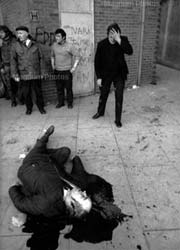 My “madeleine” happened in a hospital in Tuzla. It was in a room with a lot of amputees. I asked myself, “God, why am I here?” And I remembered that my father was a soldier; he lost his arm during World War II. It’s something I lived with before. I started to think about those people, how many stories they had heard from their childhood, from World War II and so on. And I started to think that there is this big curse of history which is that you are damned if you remember and you are damned if you don’t. If you don’t remember you’re condemned to repeat the same mistakes. But if you do remember there is also a chance that you may repeat those mistakes. I think there is a real problem with how history is being transmitted to us, how we integrate it both individually as memories, as personal memories of our families, our parents, what they went through, and collectively. It’s something that strikes me as very vivid in this period, that there is a real crisis both collective and individual of history, and a real curse.
My “madeleine” happened in a hospital in Tuzla. It was in a room with a lot of amputees. I asked myself, “God, why am I here?” And I remembered that my father was a soldier; he lost his arm during World War II. It’s something I lived with before. I started to think about those people, how many stories they had heard from their childhood, from World War II and so on. And I started to think that there is this big curse of history which is that you are damned if you remember and you are damned if you don’t. If you don’t remember you’re condemned to repeat the same mistakes. But if you do remember there is also a chance that you may repeat those mistakes. I think there is a real problem with how history is being transmitted to us, how we integrate it both individually as memories, as personal memories of our families, our parents, what they went through, and collectively. It’s something that strikes me as very vivid in this period, that there is a real crisis both collective and individual of history, and a real curse.
What exactly is that crisis? That we distort the history? We don’t recall the history? What’s going on?
I think this is like a mathematical equation. Since we are obviously repeating some of the mistakes of the past, whether it is in Bosnia, the Bosnians repeating the mistakes, or whether it’s at the level of the UN which is repeating the same mistakes as the League of Nations, or whether it’s among the Western powers who are passively negotiating with evil the same way they did in the years prior to World War II, there is a repeat of history. So if there is a repeat of history it means that we’ve not understood it well. That means we’re not transmitting it well, understanding it well. There is a real crisis. I feel it’s like a frontier for us, to understand and transmit to the younger generation the past better, so that there is no repeat. That’s it.
You are also suggesting that this is something personally that each individual has to work through. That is, the way in their work or in other ways that they deal again and again with images that they have experienced as children. Is your photography, especially in Bosnia and Rwanda, addressing that problem for you as an individual?
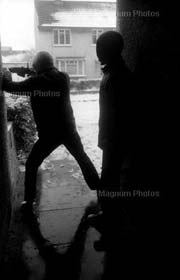 The absence of images also, because in my case actually my parents told me very, very little about what happened, and showed my very, very little. Yes, I do think that individually we have to deal with this issue. But also I think that we have to figure out collectively how to deal with it.
The absence of images also, because in my case actually my parents told me very, very little about what happened, and showed my very, very little. Yes, I do think that individually we have to deal with this issue. But also I think that we have to figure out collectively how to deal with it.
As a photographer you are empowered in a special kind of way to deal with this dilemma, which maybe all individuals confront – finding those images that help deal with their own personal past.
Yes, absolutely. But in my case, I think I will have to stress, it’s the absence of images. And I do have a certain resentment in a certain way toward my educators and a little bit toward my parents for not telling me the truth about what reality really is. And I think at some level, war and the most heinous part of war — when it comes to war crimes, and so on — it’s all put neatly under the carpet, as a reality. There is a certain mystification and a certain glorification of war, and the whole thing about what it is to be a soldier and so on. I’ve now been doing this for a long time, and I’m not a war photographer. I don’t have this identity, it’s one that I would also reject. But I did find myself quite a few times in fairly conflictual situations. And I see young soldiers and I see young marines that learned somewhere, and I really feel sorry for those kids because they don’t know. They think it’s like a nice movie. Sure, there are casualties and so on, but they’re not prepared for what is the reality of war. And I think that civilians here do not have any notion of what it is.
So you focus on almost a Platonic ideal of truth, the place where the stark reality is –
It’s where you come out of the cabin, in the light, and you see reality for what it really is. It’s about the truth.
The Process
When you leave these places and you put together a book, does that end the process of being haunted by the memories, or do they still stay with you after you’ve moved on to the next assignment?
First, I don’t have assignments. I wish they were. Yes, it’s a whole process.
When I leave for any place, whether it’s Bosnia or Rwanda and so on, I try to have as little a preconceived idea [as possible] about what is that place, what is happening there, what I’m going to do there, and what is the final project going to be. For me the whole process of going, staying, trying to spend as much time understanding and then doubting my own understanding, being extremely subjective but through the process of doubting myself coming to some kind of objectivity, coming back, editing the pictures, living with those pictures, putting the books together and so on — it’s a process by which I try to understand. It’s only at the end, once the book is there, that I have some sense of what it is I went through, what it is that I was confronted with both outside but also inside, because to anything you bring your own inner world. So it’s a painful process. I mean, during the process of doing the Rwanda book I was in a serious depression for the whole period. I had this feeling that I was going to vomit all the time. You know, you live with it.
Let’s talk a little about what you’ve just said. You go into Rwanda: do you do any research on the history of the conflict?
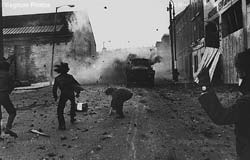 Some, but I try to avoid having a script — I’m going there and this is what I’m going to find out and this is what I’m going to illustrate, and so on. You know, it’s really very much a dialog with reality.
Some, but I try to avoid having a script — I’m going there and this is what I’m going to find out and this is what I’m going to illustrate, and so on. You know, it’s really very much a dialog with reality.
You see, I also have a strange notion as to what is a picture. I see that an image has several authors: there is yourself; there is the camera (because I think that photography through each camera speaks in a different way); there is reality, because reality speaks very forcefully through photography; and then there is the viewer, which is a person who looks at the image, makes his own interpretation of what’s happening. And I do think that photography is very much “open text,” where half of the text is in the reader. So for me to go anywhere with a preconceived notion of what it is that I’m going to do, what it is that I’m going to say, and what it is that I’m going to tell you, would be a fairly delusional, self-defeating project.
So you get off the plane. Do you go right to the front? I’m left with the sense that the stories that you are telling by capturing what you see are really stories of the people and how they are being affected by what you call the “curse of history.”
Well that’s very evident in these two books because they deal with very dramatic situations. To answer the first part of your question, it really depends. In the next book on Bosnia, what happened is that I said to myself (it was prior to the ’95 offensive, just after Srebrenica, prior to Dayton) “Well all right, I want to take a second look at the situation.” When I came off the plane I actually started to drift into an antiquated Illyric tribes role. I started to look at the past of that region. And I started to approach this whole reality from a totally different angle than I had that time around. So it’s unpredictable. Thank God.
The Meaning of Images: Bosnia
Let’s talk about these two books. The one book which we have here is Farewell to Bosnia. You did this a couple of years ago?
The project was done in ’93 – ’94.
Let’s take an image that we can show on the camera and talk a little about it, and go back to what you were saying before about there being many authors: you, the camera, and the reality. Tell us how you came to take that image.
At first I have to warn you that the structure of the book itself is really according to this whole open text theory, which is that I consciously didn’t edit the book. The book is really organized in sequences of images and in a certain way I leave an enormous amount of work to you, the reader, to reconstruct what the reality is and to make up your own reality into it, rather than me telling you this is the meaning of this image. But you chose this one. So maybe you can tell me why you chose this one.
Okay, but for our audience let’s contextualize if we can. This is occurring as the Serbs are moving in. The structure of this book is determined by the course of the conflict, is that correct?
Yes.
You’re going into the different places where the Serbs are coming or they’re about to come or they’ve just been.
Yes. It’s the siege of Sarajevo. It’s also the war in central Bosnia between the Croats and the Bosnians. All right, I’m very much like Fabrice del Dongo at the Battle of Waterloo in Stendhal’s The Charterhouse of Parma. He was there, but history, as it unfolds, is not always a very obvious monument or architecture in front of you. There is a lot of the trivial of life and there is a lot of notions of simultaneity of life, of life that goes on while catastrophe unfolds, and so on. And this is why I work the way I do; I work extremely open to what’s around me. I document from the most minute detail to the most spectacular scene. Sometimes, in some projects like the new Northern Ireland project, in the structure of the book I will make an effort to describe the simultaneity of things as they unfold. So, yes I do work in a very open way and I document everything that’s around me. It’s a very existential approach. I shoot pictures of the glass of water I drink if I feel that it means something at that time.
So in a way it’s a collection of images that come into being in an honest effort to capture what is going on. But in the final analysis it’s the viewer who has to ask the right questions of himself and of the photograph, is that correct?
Yes, do some work to reconstruct.
Now in this photograph which I picked, as I look at it, clearly your images do empower you to think about what’s happening to these people. Obviously the glass is separating them. They’re still trying to reach out. This is obviously taken in some sort of vehicle, so people are being forced to move.
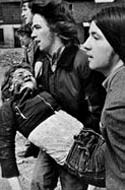 They are being separated.
They are being separated.
Because I have a family, because I’m really sensitive to those family issues, I’m extremely moved always when I see how those conflicts impact families. One of the things that always moves me the most is when I arrive on a scene and I see those family albums lying on the floor. And there’s always a picture of a child from a better time. And you really wonder what’s happened to that family, what happened to that child. And the tearing apart of the family, that always affects me the most. With Eric [Stover] we went to document the graves at Srebrenica. In the morgue a lot of people had those pictures of their family, and the pictures had bullet holes through them. The pictures were half decomposing from the body fluids. And yet you could still see a child being held by his mother and so on. And the reality is that its families like your family, my family, that are being totally affected. And when you think about all of those issues, you have to think of your own child and your own family in this situation.
So not only are you taking pictures of what this “curse of history” is doing to these people and how their lives are being ripped apart — and I think in some parts of Bosnia the middle class existence is being torn asunder — but you hope that it will resonate with the viewers’ own lives in the sense that they will compare their own order to the disorder of these events. Viewers can ask questions based on their knowledge of their own lives in the picture that we were looking at. In capturing the everyday existence turned upside down, you are empowering the viewer to think.
There’s a moment where my language finishes and yours starts. In a certain way mine ends here and yours starts when you choose the image and you start to think why.
It’s really an ongoing dialogue to evoke the conscience of people about the atrocities that are going on in Rwanda and Bosnia. You said that that was the second great evil, that the West and the great powers were not responding. This is a vehicle for doing that.
In the law in France there is such a crime as non-assistance to a person in danger, which is that you can go to jail for not assisting somebody in danger. On the basis of this crime there are lots of people, even in our own government here that could go to jail.
The Meaning of Images: Rwanda
This is a picture from the book on Rwanda, The Silence. It raises another interesting level which is, in the first picture we were looking at, one reacts based on one’s knowledge of everyday experience. Now what struck me about this picture is that “Hutu” is written on the door, which in this context was an indication that the people in this house should not be killed. Because what we had was the Rwandan government leadership, which was Hutu, systematically killing Tutsis. Now when I look at my own reaction, this first reminded me of the Bible when Moses went to Pharaoh and asked that the children of Israel be released and the Pharaoh refused and God ordered the plagues. A mark was put on the door of the homes of the Israelites, so that God would spare them. Now what’s interesting here is that this is man doing this. If God is involved, it’s the 50/50 God that you were talking about earlier.
Right.
Now what I’m curious about is, I do this reading and it’s a personal reading based on the knowledge that I bring having read the Bible growing up in school.
Yes, that’s correct. But that’s what actually happened. That’s why they were writing “Hutu” on the houses.
So you’re going into the situation which you have defined as confronting reality and seeing the lies and illusions, and you’re attempting to create a gallery where people can bring their own personal sense of what this means.
But I’m proposing something to you and you’re actually going with it at some level. I’m proposing to you that photography is a language on its own, which is that when you look at images you do derive ideas; and I’m also proposing to you that you can derive ideas without going through words. So I’m forcing you to really look. And this process of looking, it’s like a new set of ideas that are being proposed to you.
Do you have a political agenda, or is that something you’re indifferent to? Is that just a by-product of what you’re doing?
A by-product.
It’s just a by-product, so it’s not central to your art.
No, my essential rationale is to understand.
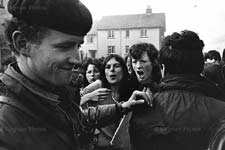 Now you are in the forefront in using new technology, not by taking the pictures but by putting your photographs up on the WorldWide Web. How do you see that tool and what is its relation to what we’ve just been talking about?
Now you are in the forefront in using new technology, not by taking the pictures but by putting your photographs up on the WorldWide Web. How do you see that tool and what is its relation to what we’ve just been talking about?
If you extend the notion of a no-man’s-land to how images are being distributed, I do not privilege one form of distribution versus another. I will publish in magazines, I will do installations in museums in an art context, I will put billboards on the highways, and I will put pictures on the web. If I could pin pictures on your bedroom walls I would. So I see the web as a place where you can create a flow of ideas, of information, and so on. In the process of doing that, because each time you do something, whether it’s with a wall or with a screen, ideas get reconfigured in a different way. You investigate new facets and new aspects of the issues. So I’ve learned quite a bit in terms of how narratives are being constructed, how the mind works at reconstructing narratives, from the web, from doing websites. And then I re-import those ideas in a book context, and so the book becomes not a book anymore but almost a screen, the same way I forced the screen to become almost a book, the same way I’ve done videos that were almost books and books that were almost videos. That’s also the no-man’s-land. The no-man’s-land is also the form.
Is there an educational goal that you have for yourself and for your viewer? Or is that too pretentious an assumption?
To the images on the web?
In the images both on the web and elsewhere. In other words, is human enlightenment the goal?
Yes.
Your personal enlightenment and…
Yes, seeking the truth. I should do interviews with you all the time; you answer half of the questions.
This is the first time this has happened! I guess I’m trying to figure out the meaning of what you’re saying for me and for my audience. But I want to go back to the earlier part of the interview and your disillusionment with political philosophy, and also pick up on something you said about the crime of silence, of not doing anything about the horrors. Is an ideal by-product of your work to mobilize people in their political consciousness in the sense that when I look at these images I am moved by them, I am frustrated by what’s happening in Bosnia and Rwanda? In terms of human enlightenment and the betterment of man, an ideal would be that I’d do something about it, right?
Yes.
Current and Future Projects
Tell us about your current work. You’re doing a book on Northern Ireland and also some work in the Middle East.
Yes. Right now I’m putting together a book about Northern Ireland. It’s a project I started 25 years ago and it’s about this 25-year period. It’s almost like a fictional diary. It’s about memory and history again in the form of a fictional diary. It’s about the simultaneity of life on different sides of a divide, and also on different sides of a class divide, which is also very powerful.
I’m also putting together this project about the process, the path to peace in Bosnia. Because I was really fascinated with the notion that once everybody says, “Yeah, it’s peace … Dayton” — everybody has this rosy notion that “Well, it’s fine. They’re fine. No problem.” Well peace is a very complicated and troublesome affair. It’s very messy, it’s not clear. And there’s a real notion also of hangover. It’s like the day after the party, you’ve trashed the house and you have to look carefully, and you can see in detail what has been the nature of war. So it’s a project I’m putting together. And I’m starting to shoot in the Middle East, yes.
On the peace process, will there be more text?
Yes, actually I think I’m going to do this one more in a film form.
So actually make a film or a video?
No, no it’s going to be a book. But it will be in a film narrative form.
I see. And the work you’re doing in the Middle East and Northern Ireland, you’re looking at particular sites over time?
It’s unfortunate that I cannot be in Hebron right now. But I work on one street corner in Hebron over a period of time.
To watch what’s going on?
I don’t know. Sometimes one functions by intuition and I want to see what comes out of that.
Conclusion
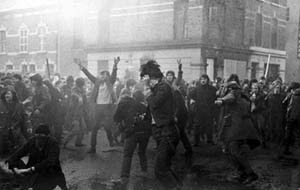 What are the most striking things you’ve learned from this odyssey, especially in the case of Bosnia and Rwanda?
What are the most striking things you’ve learned from this odyssey, especially in the case of Bosnia and Rwanda?
Remember when we were young and we said don’t trust anybody over 30? I think that was right, don’t trust anybody over 20! I think that there is a real necessity to provide young people with the tools to understand history, what has really happened. And I think that they themselves should be suspicious about what they’re being told.
How then might they develop the critical faculties to do the kind of thinking that you’ve been suggesting that everybody should be doing? Go out and do? Or sit and think?
Go out and do. Go out and do, very much. But you see, my generation was really steeped in the “go out and do” in the political form. I think we have to figure out a new form that allows people to go out and do, to confront themselves with the realities of the world, with the moral choices between good and evil, and to figure out a way to deal with these issues. There has been such a change. The whole humanitarian movement is an expression of this change; you know, the fact that we have young people joining MSF [Médecins sans Frontières, Doctors without Borders] and going to Africa and so on. But I think it’s a process that has to be extended to other parts of society.
And how does one do that? In other words, how might people be empowered to do that?
There’s a big choice to be made right now. Either you fall on the postmodernist incapacity for dealing with the world, which is that there is no accurate description of the world so there is no point in going out to look at the world. And if you’re not going to look at the world then certainly you’re not going to change it. The whole issue is, can the world be changed or is the world always going to be the same? I think that’s very much the choice that we all have — that I have, that you have, that young people have. Can the world be changed? I think that this choice, at least the choice, has to be presented to them. if the world can be changed, what are you going to do to change it? What is progress? What is progress in the context of history? How do we formulate all those things? But anyway, that’s your job. You’re in a university, you do curricula. You prepare them for that, and the results of other people’s intentions.
With that note we’ll conclude. I have to say that I wonder if we’re accomplishing as much as you’re accomplishing. Thank you very much for taking time — I was going to say for letting me interview you, but maybe thank you for interviewing me! I hope that this process has contributed to our audience’s understanding of what you’re trying to do and how your images may be changing the way people think. Thank you very much.
Thank you.
And thank YOU very much for joining us for this “Conversation with History.”

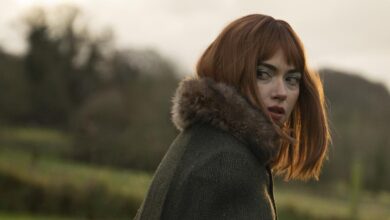
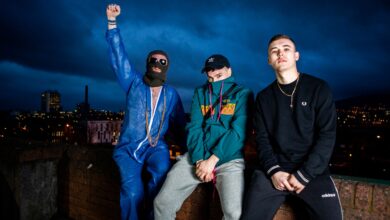
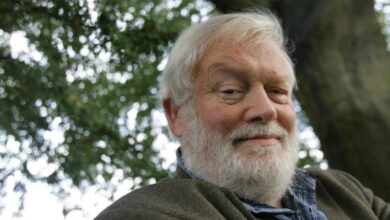
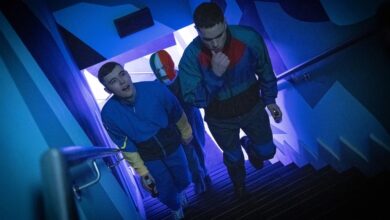
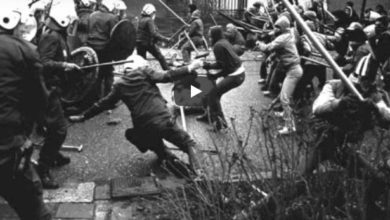
2 Comments